
The City and Borough of Juneau, more commonly known simply as Juneau, is the capital city of the state of Alaska. Located in the Gastineau Channel and the Alaskan panhandle, it is a unified municipality and the second-largest city in the United States by area. Juneau was named the capital of Alaska in 1906, when the government of what was then the District of Alaska was moved from Sitka as dictated by the U.S. Congress in 1900. The municipality unified on July 1, 1970, when the city of Juneau merged with the city of Douglas and the surrounding Greater Juneau Borough to form the current municipality, which is larger by area than both Rhode Island and Delaware.

Douglas is a community on Douglas Island in southeastern Alaska, directly across the Gastineau Channel from downtown Juneau.
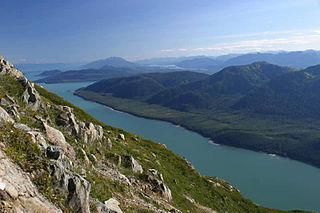
Gastineau Channel is a channel between the mainland of the U.S. state of Alaska and Douglas Island in the Alexander Archipelago of southeastern Alaska. It separates Juneau on the mainland side from Douglas, on Douglas Island. The first European to sight the channel was Joseph Whidbey whilst serving on the Royal Navy's Vancouver Expedition early in August 1794, first from the south and later from the west. It was probably named for John Gastineau, an English civil engineer and surveyor.
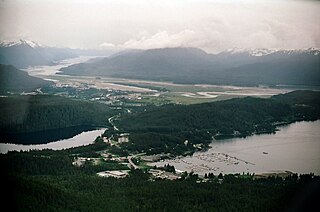
Auke Bay is a neighborhood located in the city and borough of Juneau, Alaska, that contains Auke Bay Harbor, Auke Lake, the University of Alaska Southeast, an elementary school, a church, a post office, a bar, a coffee shop, a waffle house, a thrift shop, a Thai restaurant, and one convenience store. The view of the Mendenhall Glacier behind Auke Bay and Mount McGinnis towering over Auke Lake are some of the most popular photo opportunities in Juneau. The ferry terminal of the Alaska Marine Highway system is also located further out the road in Auke Bay at about 14 miles. The flamingo house on Auke Lake is a local attraction, known for its topical or weather-related formations of pink lawn flamingos. Whale watchings targeting curious humpbacks are available. Humpbacks in these areas are known to demonstrate special feeding methods, so-called "bubble-net feeding", and come very close to shores.

The Treadwell gold mine was on the south side of Douglas Island, .5-mile (0.80 km) east of downtown Douglas and southeast of downtown Juneau, owned and operated by John Treadwell. Composed of four sub-sites, Treadwell was in its time the largest hard rock gold mine in the world, employing over 2,000 people. Between 1881 and 1922, over 3 million troy ounces of gold were extracted. Not much remains today except for a few crumbling buildings and a "glory hole". Although John Treadwell had twelve years of experience in both placer and lode mines, he was a carpenter and builder by trade who had come to Alaska prior to the Klondike Gold Rush.
The Juneau mining district is a gold mining area in the U.S. state of Alaska.

Douglas Harbor is a harbor off the coast of Douglas Island in Juneau, Alaska.
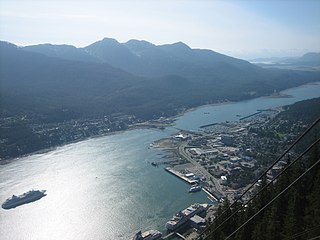
West Juneau is a populated place in Juneau, Alaska, United States. It is located on Douglas Island 1.8 miles (2.9 km) northwest of Douglas. Despite its location on Douglas Island, the neighborhood was juridically a part of the City of Juneau, rather than the City of Douglas, prior to municipal unification in 1970.

Tee Harbor refers to two adjacent populated places in the City and Borough of Juneau, Alaska. The area had a population of 32 in 1950. It is located 3 miles (4.8 km) northwest of Fairhaven and 17 miles (27 km) northwest of the main city of Juneau.

Kowee Creek is a river on Douglas Island in the City and Borough of Juneau, Alaska, United States. Its origin is southeast of Mount Troy and it flows north-northeast to Gastineau Channel near West Juneau; it is 0.5 miles (0.80 km) southwest of the city of Juneau. Kowee Creek is nearly 10 miles (16 km) long. It has a drainage basin of about 50 square miles (130 km2) and two transverse tributaries.
Ninemile Creek is a river on Douglas Island in the City and Borough of Juneau, Alaska, United States. Its origin is in hills to the southeast and it flows northwest to Gastineau Channel near West Juneau. It is 1.2 miles (1.9 km) east of Entrance Point and 6.4 miles (10.3 km) northwest of the city of Juneau.
Elevenmile Creek is a river on Douglas Island in the City and Borough of Juneau (CBJ), Alaska, United States. Its origin is in hills to the southeast and it flows northwest to Fritz Cove, a part of Stephens Passage; it is 1.6 miles (2.6 km) southwest of Entrance Point and 8.6 miles (13.8 km) west of the city of Juneau.
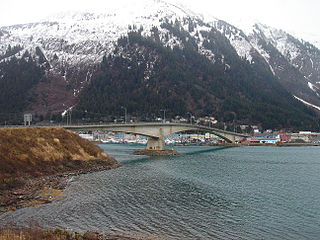
The Douglas Bridge is located in Juneau, Alaska. Spanning the Gastineau Channel, it connects Juneau's eastern, mainland side with the city's communities on Douglas Island to the west. The current span is the second bridge of the same name; the original, built in 1935, was demolished in 1981 following the completion of its replacement in 1980.
The Alaska-Gastineau Mining Co. had its offices in 25 Broad St., New York City, New York. It was the operating company for the Alaska Gold Mines Co. in Alaska. It worked the Alaska-Gastineau Mine/Perseverance Mine in the Silver Bow Basin, approximately 4 miles (6.4 km) from Juneau and processed its ore at an old remodeled mill and crushing plant at Sheep Creek. The property of the Alaska Juneau Gold Mining Co. adjoined the Alaska Gastineau on the west.

The Alaska-Juneau Gold Mining Company (AJGMC) was incorporated under the laws of West Virginia, USA in 1897. Its lode mining claims covered approximately 402.37 acres (162.83 ha) on the wide vein called the Juneau gold belt of which it owned one mile on the outcrop.
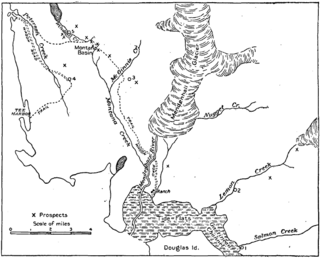
Lemon Creek is a stream in the U.S. state of Alaska. It is primarily filled by the meltwater of Lemon Creek Glacier, as well as another glacier. The Lemon name is said to come from traveling miner John Lemon, who reportedly had a placer mine on the creek in 1879.
John Treadwell (1842–1927) was a Canadian gold miner. He was born in St. Andrews, New Brunswick, Canada. He owned and operated the Treadwell gold mine through the Treadwell Mining Company. He was responsible for initiating low-grade gold mining in Alaska adopting most advanced operations on a big scale, which boosted the economy of the wilderness areas. His four mines formed the largest complex in the world at that time. Treadwell's mine complex "put Juneau on the map".

The Juneau gold belt is located in the southeastern portion of the U.S. state of Alaska. This belt is approximately 100 miles (160 km) in length, north/northwest-trending, and extends from Berners Bay southeastward to Windham Bay, 60 miles (97 km) southeast of Juneau, and includes Douglas Island. The belt contains over 200 gold-quartz-vein deposits with production nearing 7,000,000 ounces (200,000,000 g) of gold. More than three-quarters of Alaska's lode gold was mined from the Juneau gold belt.
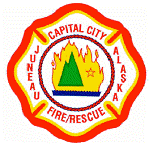
Capital City Fire/Rescue (CCFR) provides fire suppression and emergency medical services to the city of Juneau, Alaska, United States.
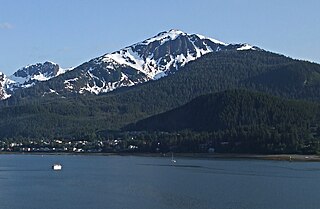
Mount Bradley is a 3,337-foot (1,017 m) elevation mountain summit located on Douglas Island in the Alexander Archipelago, in the U.S. state of Alaska. It is the third-highest peak on the island, and is situated 4 mi (6 km) south of Juneau, on land managed by Tongass National Forest. Although modest in elevation, relief is significant since the peak rises up from tidewater of Gastineau Channel in approximately two miles. Its nearest higher neighbor is Mount Ben Stewart, 5.6 mi (9 km) to the northwest.



















